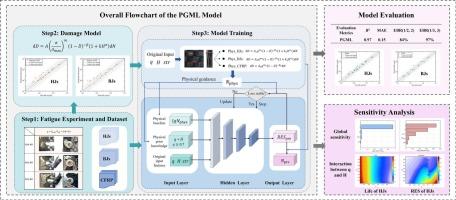基于物理引导机器学习的CFRP/Al复合(铆接/粘接)接头和粘接接头湿热载荷下疲劳寿命预测框架
IF 6.8
2区 材料科学
Q1 ENGINEERING, MECHANICAL
引用次数: 0
摘要
轻量化材料的广泛应用对异种材料连接技术提出了挑战。碳纤维增强聚合物/铝合金(CFRP/Al)结构中常见的混合(铆接/粘合)接头(HJs)和粘合接头(BJs)具有良好的疲劳性能。然而,湿热条件和机械载荷的耦合使疲劳破坏机制复杂化。由于实验数据有限、多物理场耦合和明显的非线性,疲劳寿命预测仍然很困难。为了解决这些问题,本研究提出了一个物理引导机器学习(PGML)框架。通过湿热疲劳实验建立了数据集,并建立了考虑湿热和载荷影响的非线性损伤积累模型。在该模型的指导下,结合物理和机器学习的优势,设计了残差神经网络来纠正系统预测误差。该方法的R2为0.97,大多数预测在2倍误差范围内。敏感性分析揭示了不同结构的特征贡献,并指出了改进物理模型的方向。本研究开发的PGML框架能够有效、准确地预测湿热载荷耦合条件下CFRP/Al接头的疲劳寿命,并为相关疲劳寿命预测问题提供了一种可扩展的方法。本文章由计算机程序翻译,如有差异,请以英文原文为准。

A fatigue life prediction framework for CFRP/Al hybrid (riveted/bonded) joints and bonded joints under hygrothermal-load conditions based on physics-guided machine learning
The widespread use of lightweight materials has presented challenges in dissimilar material joining technologies. Hybrid (riveted/bonded) joints (HJs) and bonded joints (BJs), common in carbon fiber reinforced polymer/aluminum alloy (CFRP/Al) structures, exhibit favorable fatigue performance. However, the coupling of hygrothermal conditions and mechanical loads complicates fatigue failure mechanisms. Fatigue life prediction remains difficult due to limited experimental data, multiphysics coupling, and pronounced nonlinearity. To address these issues, this study proposes a physics-guided machine learning (PGML) framework. A hygrothermal fatigue experiment was conducted to construct a dataset and to develop a nonlinear damage accumulation model that accounts for both hygrothermal and load effects. Guided by this model, a residual neural network was designed to correct systematic prediction errors, combining the strengths of physics and machine learning. The approach achieved an R2 of 0.97, with most predictions falling within 2 times error band. Sensitivity analysis revealed feature contributions across different structures and indicated directions for improving the physical model. The PGML framework developed in this study enables efficient and accurate fatigue life prediction for CFRP/Al joints under hygrothermal-load coupling conditions and provides an extensible methodology for related fatigue life prediction problems.
求助全文
通过发布文献求助,成功后即可免费获取论文全文。
去求助
来源期刊

International Journal of Fatigue
工程技术-材料科学:综合
CiteScore
10.70
自引率
21.70%
发文量
619
审稿时长
58 days
期刊介绍:
Typical subjects discussed in International Journal of Fatigue address:
Novel fatigue testing and characterization methods (new kinds of fatigue tests, critical evaluation of existing methods, in situ measurement of fatigue degradation, non-contact field measurements)
Multiaxial fatigue and complex loading effects of materials and structures, exploring state-of-the-art concepts in degradation under cyclic loading
Fatigue in the very high cycle regime, including failure mode transitions from surface to subsurface, effects of surface treatment, processing, and loading conditions
Modeling (including degradation processes and related driving forces, multiscale/multi-resolution methods, computational hierarchical and concurrent methods for coupled component and material responses, novel methods for notch root analysis, fracture mechanics, damage mechanics, crack growth kinetics, life prediction and durability, and prediction of stochastic fatigue behavior reflecting microstructure and service conditions)
Models for early stages of fatigue crack formation and growth that explicitly consider microstructure and relevant materials science aspects
Understanding the influence or manufacturing and processing route on fatigue degradation, and embedding this understanding in more predictive schemes for mitigation and design against fatigue
Prognosis and damage state awareness (including sensors, monitoring, methodology, interactive control, accelerated methods, data interpretation)
Applications of technologies associated with fatigue and their implications for structural integrity and reliability. This includes issues related to design, operation and maintenance, i.e., life cycle engineering
Smart materials and structures that can sense and mitigate fatigue degradation
Fatigue of devices and structures at small scales, including effects of process route and surfaces/interfaces.
 求助内容:
求助内容: 应助结果提醒方式:
应助结果提醒方式:


